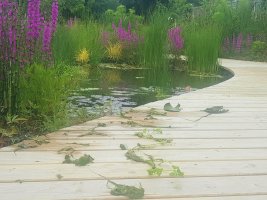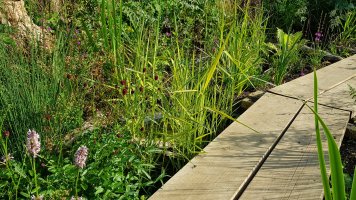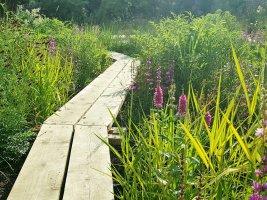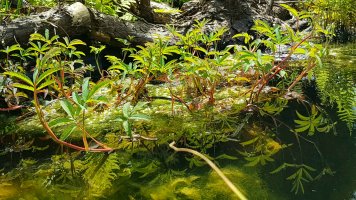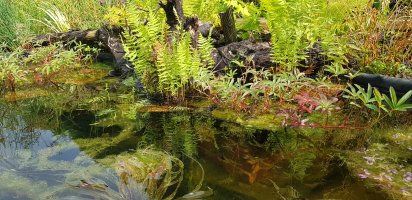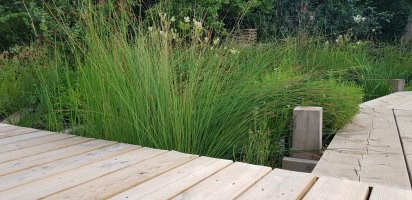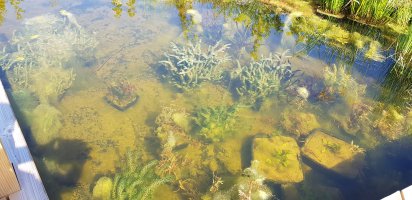I have been extremely lucky with the weather. It has been raining so often, and during most weeks since the plants went in, so I have had to water very little, which has been a great help. And they are growing so fast! The Lythrum (purple loosestrife) are providing most of the colour at the moment and are growing well, both in the water and in the garden. They dominate the planting schemes around the first three ponds:
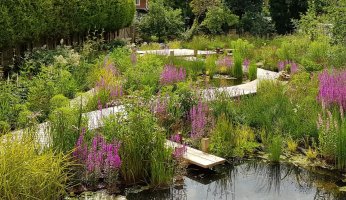
Middle ponds;



Butomus umbellatus are in flower and it is hard to think of a more beautiful marginal plant. I planted it mainly around the pond near the house. They grew taller than expected and I am sure they are taller than the 90cm often advertised as their max height. I planted them in washing up bowls as I read they are heavy feeders and needed more space. One downside is that their foliage starts to die back while they are still in flower but I forgive them. The young Lythrum look at bit out of place next to them but next year should be of a similar height.



Where the woodland planting meets the water at the edge of the middle pond, Potentilla palustris (marsh cinquefoil) and Thelypteris palustris (marsh fern) are starting to spread out. I originally had three baskets of Thelypteris but one of them did not take. Both Potentilla and Thelypteris are planted in baskets just below the water level.

The Norfolk reed, Phragmites australis, which I planted in the seven tubs I dug in along one of the boardwalks, are slowly becoming more visible. They went in as young plants but are now starting to rise up among the other planting.



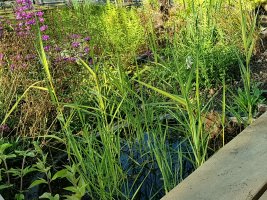
Each tub has a water level of around 15-20cm and a deep substrate of clay topsoil. I was not sure at first if this would really work - so much garden soil with only a relative small amount of water over it but the water quality has remained good. I did plant Elodea in all of the tubs as well.
Lots of Sanguisorbas have been planted throughout the garden and are starting to flower. Harder to capture on camera, but the mass of small dark flower heads above the planting looks quite impressive. The pics below show the edges of the back ponds with Sanguisorba officianalis (great burnet) and Filipendula ulmaria (meadowsweet) in flower. Also pictured are the seed heads of Silene flos-cuculi (Ragged Robin).


Waterlilies are doing well also. Most were bought last year and planted in small washing up bowls, to give them more soil/nutrients than pond baskets can hold. First picture below is Nymphaea odorata 'Alba' with Oenanthe fistulosa sending out runners along the boardwalk. Second picture Nymphaea 'Moon Dance', probably my favourite lily right now. I like how it holds its flowerhead above the water and also like its speckled leaves.



I have a few pink/purple coloured waterlilies which managed to survive a few years of neglect in my tubs, when hardly any leaves made it through to the surface because the tubs were full of pond plants/thread algae. This spring, I repotted them and was surprised how they bounced back. They never flowered before and I was a bit disappointed in their colour as I find the purple flowers a bit unnatural looking, but they still have a certain beauty and do match the purple of the Lythrums.
Water is clear in all of the ponds. Thread algae is still there, more in some ponds than in others, but on the whole I am noticing I am pulling out less as the weeks go by. Also, more and more of it is starting to float, making it easier to remove what remains. The vallisneria is starting to grow. I wonder if I have too many pond baskets in there, in the sense that there might be too many plants that want to grow fast (Elodea) and not enough nutrients available because of it? On the second pic, you can clearly see which baskets with Elodea I have fertilised and which I have not.

 As recommended by @zozo
As recommended by @zozo, I planted some Potamogeton gayi - five baskets thanks to a generous portion sent to me by Wookii



I still have more planting to do. Apart from some perennials, I still have a few crates of pond plants waiting to go in (pic below); Schoenoplectus lacustris, Juncus, Juncus inflexus, Preslia cervina (water spearmint), Pilularia globulifera and Potamogeton lucens. Today, I found some Potamogeton perfoliatus on sale, which I had been looking out for.

The plants in crates (waiting to be planted up) are kept in the very back pond (
the extension pond). As these plants are still in their original 9cm pots, filled with peat, the water there has turned a bit brown. I also think it might have affected the Sium Latifolium which has almost died back in this pond. Could the peat have made the water too acidic for the Sium? It seems to be doing ok in the pond next to it:


Another plant which does not seem to be doing too well is Stratiotes Aloides (water soldier). In some ponds they have practically disappeared. In the pond below, you can see how they seem to disintegrate, although a few do show signs of emerging. The second pic shows a much healthier one in another pond of mine. I have seen pictures of them growing much lusher and already growing properly above the water surface this time of the year. Could it just be a lack of nutrients? Too many oxygenating plants competing for nutrients and not enough muck on the bottom of the ponds for them to feed of (as the ponds are only one year old)? Its a real shame as I was hoping for a dramatic display, I put in so many last year.


Not helping are the crows. I wrote earlier in the journal how they visit many times a day, walking around the ponds looking for pond snails. I used to be well impressed with them, as they had learned to drag out strands of thread algae in order to get to the snails caught in between. They have now improved their tactics and have started pulling up lily pads and even ripping out marginal plants in order to catch more snails. I am no longer a fan!


